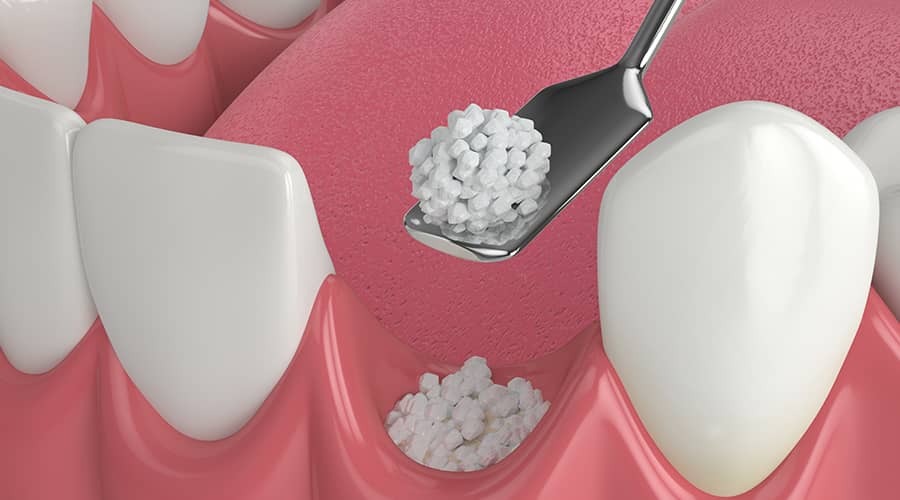The Role of Bone Grafting in Dental Implants Explained

Dental implants have revolutionized the way we replace missing teeth, providing a long-lasting, stable, and natural-looking solution. However, one of the key factors in ensuring a successful dental implant procedure is a strong, healthy jawbone. Unfortunately, many people who require dental implants may have experienced bone loss due to gum disease, injury, or long-term tooth loss. This is where bone grafting comes into play, a procedure that can make dental implants possible for those with insufficient bone structure.
In this blog, we will explain the role of bone grafting in dental implants, its importance, types of grafts used, the procedure, benefits, and potential risks. By understanding the role of bone grafting, you’ll gain a deeper appreciation of why it’s essential for a successful and lasting smile.
What is Bone Grafting?
Definition of Bone Grafting
Bone grafting is a surgical procedure that involves adding bone material to the jawbone to encourage bone growth and strengthen areas with insufficient bone density. This procedure helps rebuild the bone in preparation for dental implants or other dental treatments.
Types of Bone Grafts
There are four main types of bone grafts used in dental procedures:
- Autografts: Bone taken from your own body, usually from areas like the hip or chin.
- Allografts: Bone obtained from a human donor.
- Xenografts: Bone derived from animal sources, commonly bovine (cow) bone.
- Synthetic Bone Grafts: Made from artificial materials that promote bone growth and regeneration.
Each type has its advantages and limitations, which are assessed by your dental surgeon based on your individual needs.
Why is Bone Grafting Important for Dental Implants?
Role in Creating a Stable Foundation
For dental implants to function properly, they need a solid foundation of bone to anchor into. Bone grafting helps create this foundation, ensuring the implant is stable and secure once placed. Without enough bone, an implant may not integrate properly, leading to failure. Bone grafting essentially “rebuilds” the area to allow for better osseointegration, the process by which the implant fuses with the bone.
Addressing Bone Loss
Bone loss is common after tooth extraction, with the jawbone beginning to shrink or deteriorate in the absence of tooth roots. This can cause a lack of bone volume, making dental implant placement difficult or impossible. Bone grafting helps reverse this process by stimulating bone growth and regaining lost volume.
The Bone Grafting Procedure
Pre-Surgery Assessment
Before any bone grafting procedure, your dentist will perform a thorough assessment, including X-rays or CT scans, to determine the extent of bone loss and identify the best areas for grafting. This helps ensure the graft is placed in the most effective location for successful implant integration.
The Bone Grafting Process
During the bone grafting procedure, your dentist will place the bone material into the targeted area of the jaw. The surgery is typically done under local anaesthesia, ensuring comfort during the procedure. The graft material will integrate with the surrounding bone over several months, creating a stable, dense foundation for future dental implants.
Recovery After Bone Grafting
Recovery time for bone grafting varies depending on the extent of the procedure, but patients can generally expect to heal within 3 to 6 months. During this time, it’s important to follow post-operative care instructions, including avoiding certain foods and activities to ensure proper healing and graft integration.
Types of Bone Grafts Used in Dental Implant Procedures
Autografts (Own Bone)
Autografts are considered the gold standard for bone grafting, as the body is less likely to reject its own tissue. However, harvesting bone from another area of your body may require an additional surgical site, which can extend the recovery process.
Allografts (Donor Bone)
Allografts come from human cadaver donors and are processed to remove any living cells, making them safe for use. They’re an effective solution for patients who don’t have enough donor bone in their own body but need a reliable graft material.
Xenografts (Animal Bone)
Xenografts use animal bone, often from cows, which is carefully processed to make it biocompatible. These grafts are widely used and well-tolerated, offering a good option when autografts or allografts are not feasible.
Synthetic Bone Grafts
Dentists make synthetic bone grafts from materials like hydroxyapatite or calcium phosphates, which mimic natural bone. These materials encourage the body’s own bone to grow over them, and they’re a popular choice due to their ease of use and reduced risk of infection.
Benefits of Bone Grafting in Dental Implant Success
Enhanced Implant Stability
The primary benefit of bone grafting is the creation of a stable foundation for dental implants. Grafting restores bone density and volume, providing a secure anchor for the implant that ensures long-term stability and function.
Preventing Further Bone Loss
By stimulating bone regeneration, bone grafting helps prevent the further deterioration of the jawbone. This not only improves the chances of successful dental implant placement but also preserves facial structure and prevents the sunken appearance often associated with tooth loss and bone shrinkage.
Long-Term Health and Aesthetic Outcomes
Bone grafting allows patients to restore their smiles with fully functional and aesthetically pleasing dental implants. The improved structure of the jawbone also contributes to better overall oral health, helping to preserve teeth and surrounding tissues.
How Long Does Bone Grafting Take?
Timeline for Bone Grafting Surgery
The bone grafting procedure itself typically takes 1 to 2 hours, depending on the size of the graft and the complexity of the procedure. After surgery, the healing process can take several months, allowing the graft to integrate with the existing bone.
When Will Dental Implants Be Placed?
Once the bone graft fully heals and integrates, which takes around 3 to 6 months, the dentist can place dental implants. Your dentist will evaluate the healing process before proceeding to the implant placement to ensure optimal results.
Potential Risks and Complications of Bone Grafting
Risks Associated with the Procedure
Like any surgical procedure, bone grafting carries certain risks, including:
- Infection
- Graft failure (if the bone doesn’t integrate properly)
- Swelling, bruising, and discomfort during recovery
Minimising Risks
Experienced dental professionals take precautions to minimise risks, such as using sterile techniques, carefully selecting graft materials, and providing clear post-surgery instructions to ensure the best possible outcome.
Do You Need Bone Grafting for Dental Implants?
Candidates for Bone Grafting
Dentists typically recommend bone grafting for patients with significant bone loss due to gum disease, injury, or long-term tooth loss. Your dentist will assess your jawbone and determine if bone grafting is necessary to create a strong foundation for implants.
Alternatives to Bone Grafting
In some cases, alternatives like sinus lifts, ridge expansion, or mini implants may be viable options for patients who don’t need extensive bone grafting.
FAQs About Bone Grafting and Dental Implants
How long does bone grafting take to heal?
Bone grafting typically takes 3 to 6 months to heal fully, although this can vary depending on the type of graft and individual healing factors.
Is bone grafting painful?
The dentist performs the procedure under local anaesthesia, and most patients report minimal pain afterward, with discomfort manageable through prescribed medication.
Can I get dental implants without bone grafting?
If there’s sufficient bone volume, bone grafting may not be necessary. Your dentist will assess your condition to determine the best course of treatment.
What happens if bone grafting fails?
If a graft fails, your dentist may recommend a second procedure or alternative treatments to achieve the desired bone density for implant placement.
Conclusion
Bone grafting is a crucial procedure in ensuring the success of dental implants, particularly for patients who have experienced significant bone loss. It restores the volume and density of the jawbone, providing a stable and long-lasting foundation for dental implants. If you’re considering dental implants and have concerns about bone loss, bone grafting could be a necessary part of your treatment plan.
Visit here for dental implants in London, and let our expert team help you achieve a healthy, beautiful smile with the support of advanced bone grafting techniques.











